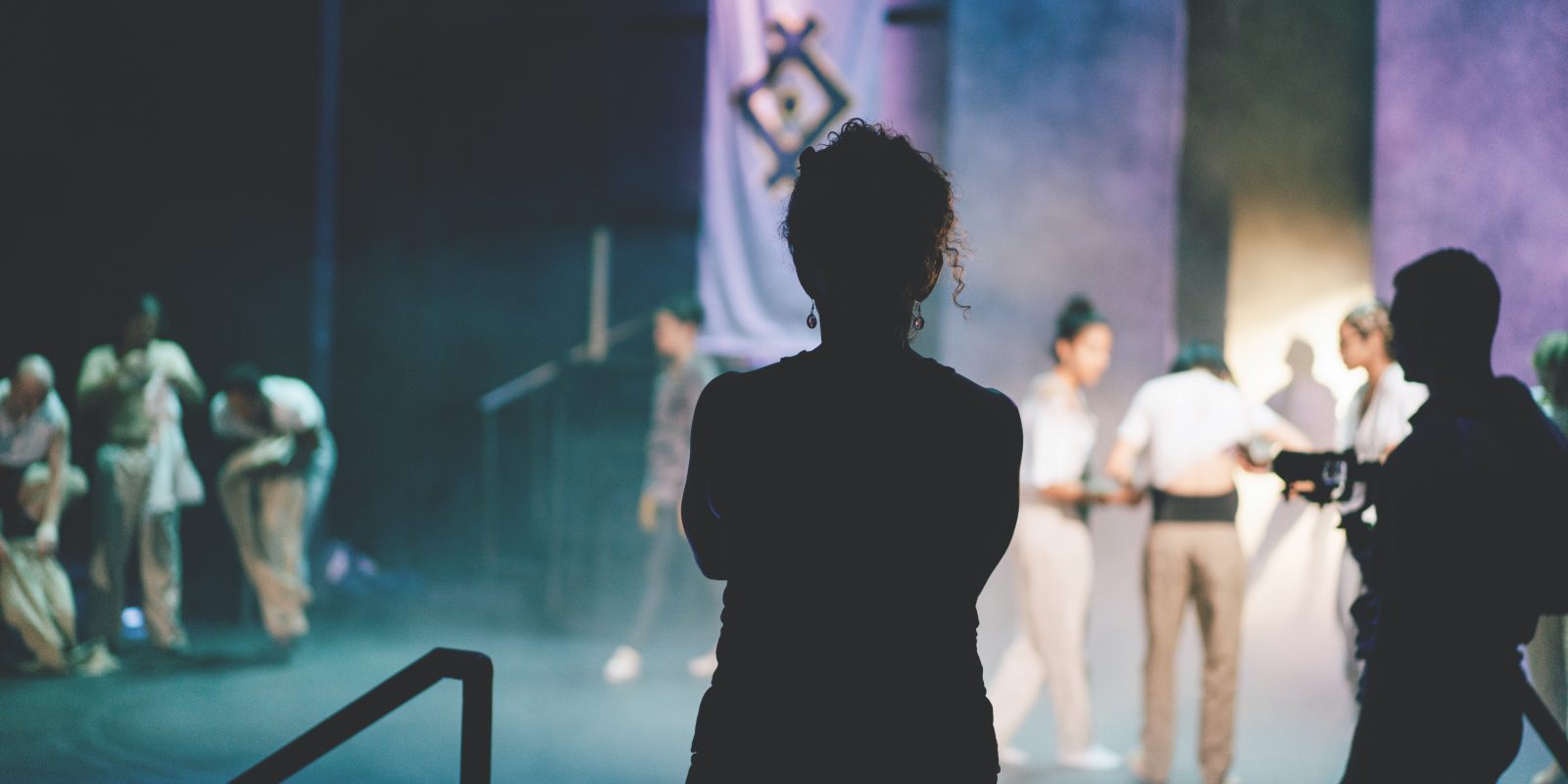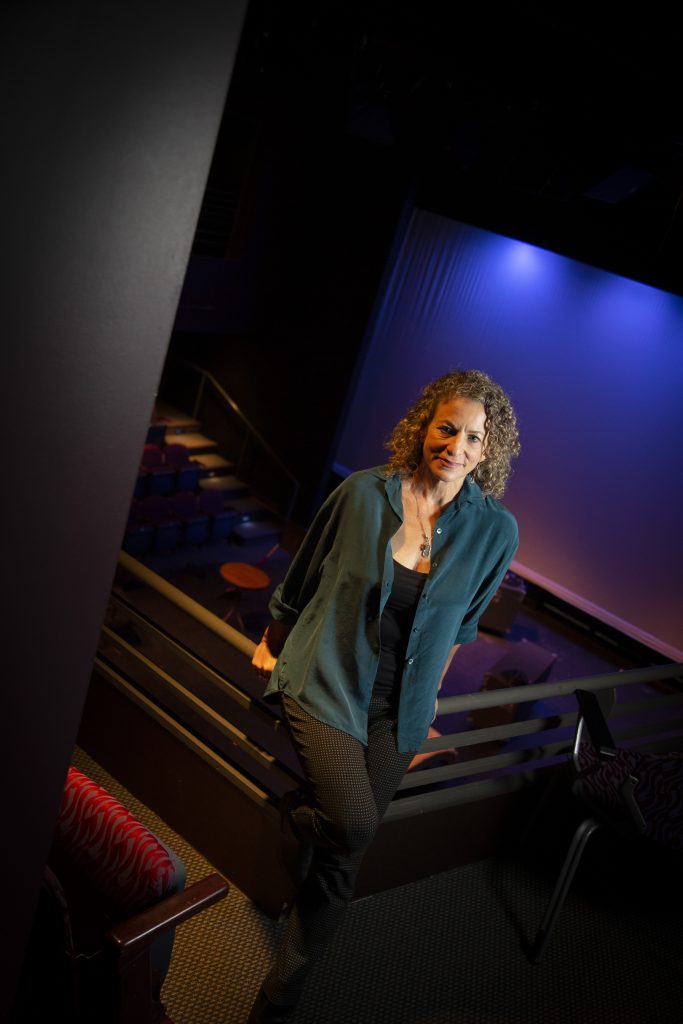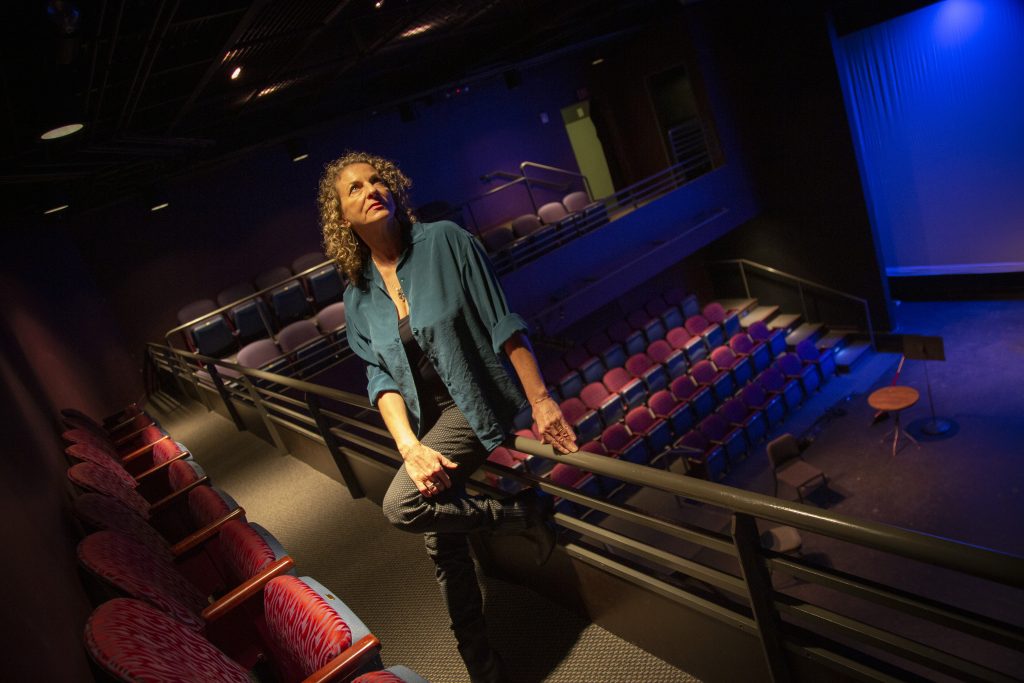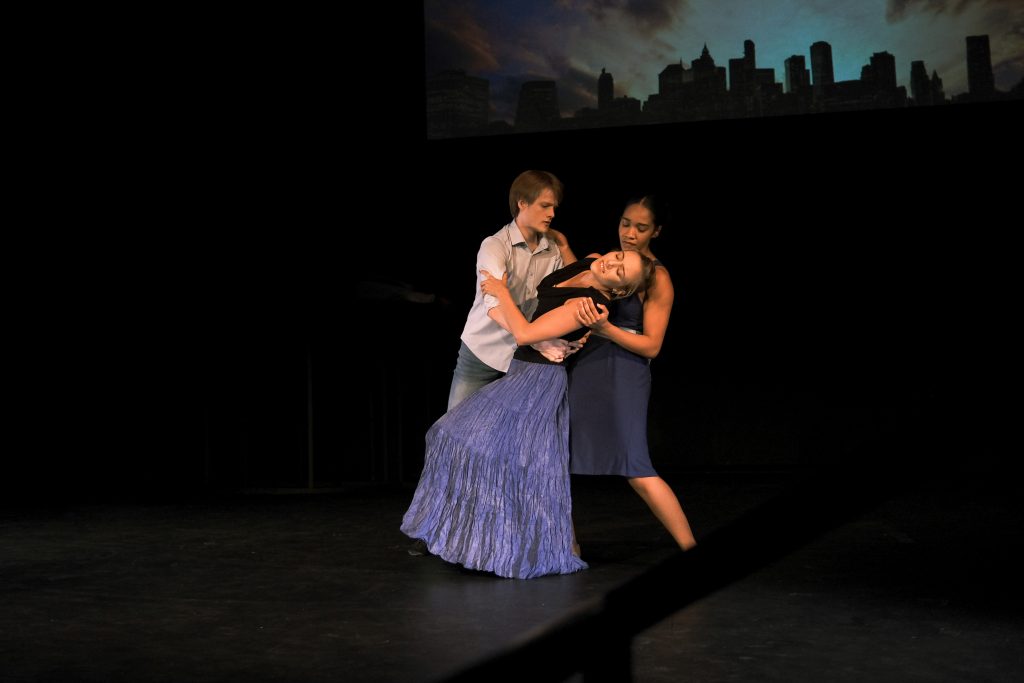
Suki John watches dancers rehearse the choreodrama she created about the impact of the Holocaust on her family. Courtesy of Suki John | M. Alimanov Photography
Survival Story
Evoking empathy through dance on film, Suki John shares her family’s Holocaust trauma.
During an early scene in Sh’ma, a choreodrama by Suki John, a teenage girl turns and leaps to ambient electronic music. While the spare set and atmospheric score imbue the work with a timeless feel, the story begins at a specific point in time and space: 1939 Hungary.
Warm moments between friends and family — a gathering in a nightclub, a candlelit Shabbat dinner — wither as fear takes root. As the government, following Nazi ideology, strips away the rights of Jewish people, the teenager’s parents argue; her mother thinks they should flee, while her father, a veteran of World War I who wants to continue his work as one of the country’s top radiologists, believes staying will be safe.
The work tells a true story, a personal one. The dancer portrays 14-year-old Veronka Polgar, the mother of Suki John, a professor in the School for Classical & Contemporary Dance at TCU. Sh’ma means listen, a word in the central prayer of the Jewish liturgy. John’s work tells a searing family story with sweeping historical consequences.
“I refer to it as the oldest story I know,” she said. “I don’t remember learning about this history. I just remember knowing it.”
Taking Shape
John recruited dancers from TCU and Texas Ballet Theater and hired three cinematographers to film Sh’ma, a work she first choreographed some 30 years ago.

The Sh’ma Project: Move Against Hate is a personal story for TCU professor Suki John. “I refer to it as the oldest story I know,” she said. “I don’t remember learning about this history. I just remember knowing it.” Photo by Joyce Marshall
Rivkah Cannon, an expert in Middle Eastern dance, designed the film costumes to feel timeless. “I wanted it to look like it could be happening now, or then, or possibly in the future,” John said.
Serbian composer Mitar “Suba” Subotić, known for his electronic music, scored Sh’ma in 1990.
The dance on film is the centerpiece of The Sh’ma Project: Move Against Hate, John’s human rights and educational initiative designed to teach audiences about the Holocaust.
The project includes workshops created with help from Lydia Mackay, professor of theatre. Offered before and after a screening of the film, the workshops invite audiences to prepare for what they’re going to see and set the stage for a response. John enlisted her cousin Michael Polgar, a professor of sociology at Penn State Hazleton, to co-edit The Holocaust: Remembrance, Respect, Resilience, a free online textbook for the project.
In 2023, The Sh’ma Project: Move Against Hate made appearances in Fort Worth and New York City museums. John has plans to share it with high schools, universities, community centers and Jewish federations. “Because it’s in a film format,” John said, “it can go from Texas to Tel Aviv.”
Family History
The project is personal for Polgar, too; his father, Steven, born Istvan, was Veronka’s brother. Through Holocaust studies and family conversations, Polgar has pieced together more of the story. Steven never spoke about the Holocaust, but Veronka and their mother, Sophie, did.
“They were forced out of Budapest, as were all Jews in Hungary,” he said, adding that most Hungarian Jews were sent to Auschwitz.
“Our family, because my grandfather was a well-known doctor, was among a small and select group of people who were sent to Bergen-Belsen,” Polgar said. “It was not a death camp; it was a concentration camp. Many people died there, but it wasn’t designed to do mass murder like Auschwitz.” Anne Frank, the same age as Veronka, died of typhus in Bergen-Belsen.
Polgar said that as the Nazis lost ground during World War II, they exchanged trains full of prisoners for resources. “On these trains — they were called Kasztner trains because they were organized by a controversial figure named [Rudolf] Kasztner — were basically ransomed refugees who were traded for trucks, medical supplies and, in the end, just money.”
Veronka and Steven Polgar’s aunt and uncle, who did not have children, gave up their spots on the first train in 1944, John said. The young Polgar siblings were thus able to ride to a home for refugees in Geneva.
“I don’t know my father’s weight when he was released, but they were sickly,” Polgar said. “My father had typhus. … They were emaciated, having been starved.”
Fearing they were orphans, Veronka and Steven Polgar nevertheless went to the train platform daily, hoping to find their parents. The happy reunion occurred four long months later, when a second Kasztner train brought more ransomed prisoners to Switzerland. Nazis and their collaborators murdered about 6 million Jewish people during the Holocaust; the Polgars were among fewer than 1,700 individuals to escape on a Kasztner train.
The Polgar family moved to the United States in 1948; the aunt and uncle who helped them also made it to America. But Veronka and Steven’s father, Ferenc, never recovered from the trauma of the Holocaust. He took his own life in 1949.
“It’s not just the trauma, it’s survivor guilt,” Polgar said. “People would kind of say … ‘Why didn’t they go to Auschwitz?’ ” When Polgar and John were growing up as second-generation survivors, Polgar said, the Holocaust wasn’t taught in their schools. “1978 was a watershed year because they showed a Holocaust miniseries on TV,” and the public was reawakened to the trauma, he said. “We have almost a sacred obligation to tell the history.”
Polgar said that inviting Holocaust survivors to speak to his students has been more powerful than lecturing.
“It’s not a history story. It’s not a war story. It’s a human story,” he said, “which is why works of art and testimonies are so important.”
The Evolution of Sh’ma
John first created Sh’ma for the People’s Theater of Yugoslavia in 1990. After she stopped by during a family trip to introduce her choreography with a VHS tape, theater directors hired her. One of the dancers didn’t want to perform the part of Veronka’s redheaded friend, whom a group of Nazis raped and murdered after she took off her yellow Star of David badge. Rather than remove the scene, John danced the role herself.

Suki John created The Sh’ma Project: Move Against Hate, which includes a dance drama about the impact of the Holocaust on her family. She first choreographed the dance in 1990. Photo by Joyce Marshall
Sh’ma was well received and went on tour in Macedonia, but the company dissolved as the Bosnian war erupted. The conflict reflected Sh’ma in jarring ways, John said. “We know what happened in Bosnia, where rape was used as a weapon of war.”
John returned to New York, where she met Keith Saunders, a dancer and ballet master with Dance Theatre of Harlem, in a physical therapy office. Nearly a decade after she first choreographed Sh’ma, John produced it again, this time in Manhattan, with Saunders’ help. Artistically, it was a success; financially, John struggled to pay the dancers.
“I couldn’t get the press to cover it,” she said. “I actually had a New York Times journalist say to me, ‘I’m tired of the Holocaust.’ ”
In New York, Veronka was able to see her daughter’s work in person. “She was extremely proud of me,” John said. “I think it was harder for my father to watch. … Thirty-nine members of his family died in rural Hungary.”
John left the East Coast to join the faculty of TCU in 2007. Saunders joined her as a professor of professional practice in 2018.
In Fort Worth, John continued to choreograph; her works included pieces focused on social justice topics like disarmament and climate change. She also taught the Art and Activism class for the John V. Roach Honors College.
But Sh’ma stayed with her.
“The targeting of people based on identity, ethnicity, political or sexual persuasion is not something that has disappeared,” John said. “The piece feels as relevant as it ever has, unfortunately. I knew I wanted to do it again.”
She spent four years securing funding. John said the first Texas organization to encourage and support Sh’ma was the Texas Jewish Arts Association, where she serves on the board as director of the dance division.
“Individual donors with the Jewish Federation really pushed the project into existence,” John said. A TCU Invests in Scholarship grant provided seed money to begin the project; two diversity, equity and inclusion grants from the College of Fine Arts paid for pre-production; and grants from the college also covered use of studio and performance spaces. The project was also funded by the Zale Foundation, Anna Sosenko Assist Trust, Texas Women for the Arts/Texas Cultural Trust and Arts Fort Worth.
“This Sh’ma project — I speak of it as Suki’s magnum opus,” Saunders said. “She has been working this material, telling this story, for upwards of 30 years.”
Sh’ma on Film
To prepare for the lead role of Veronka Polgar in the film, Kira Daniel ’23, who majored in modern dance at TCU, pored over Veronka’s journal and read Elie Wiesel’s Night, a haunting Holocaust memoir.

During the choreodrama Sh’ma, a Jewish family decides whether to attempt to flee Hungary or remain home as ethnic oppression grows before World War II. The Polgars, Suki John’s family, are portrayed by, from left, Texas Ballet Theater’s Adam Phillips and Samantha Pille and TCU’s Kira Daniel, a recent modern dance graduate. Courtesy of Suki John | M. Alimanov Photography
“Every scene that we work on, as soon as I go home and read the book, it’s literally the exact same; it’s just so real and raw,” Daniel said. “Every day, I feel like I’m closer to doing justice to her mother.”
Saunders portrayed Veronka and Steven’s father, Ferenc. In a heartbreaking moment that shows the dehumanizing impact of trauma, Ferenc, starving in a concentration camp, steals bread from his son. “It’s maybe that moment that I realized the full weight of it,” Saunders said.
In creating Sh’ma, John said she felt some release of the intergenerational trauma passed down to descendants of survivors. She experienced frequent war dreams until 1990. “After I made one of the hardest scenes in the ballet, the war dreams went away.”
Revising the work for film brought more release. She added a moment to Sh’ma where shoes are piled on stage; a Holocaust museum in Jerusalem inspired the scene. “I just felt all those shoeless souls around me and started having chills,” she said. “The dancers came and hugged me. It was beautiful to acknowledge.”
Daniel said performing in Sh’ma deepened her perspective on her chosen career. “Dance is just so much bigger than me going into a studio, learning a couple of moves and performing in front of people,” she said. “It can heal. It can bring communities together, give people hope.”
“Dance evokes kinesthetic empathy,” John said. “When you watch someone do something with their body, you feel it in your own body … in the kishkas — it gets you in the guts.”
Editor’s Note: This story about Suki John’s Holocaust choreodrama was reported in 2022, before the current violence involving Israel and Hamas.

Your comments are welcome
Comments
Related reading:
Research + Discovery
Obstacles to Education
Experiences of Black students and parents are at the center of Endia Lindo’s book.
Alumni, Features
Called to Help
Morgan Davies brings services to deaf children and their families.
Alumni, Features
Designing a New Life
With help from TCU alumni, a Ukrainian woman finds a safe haven and opportunities in Fort Worth.